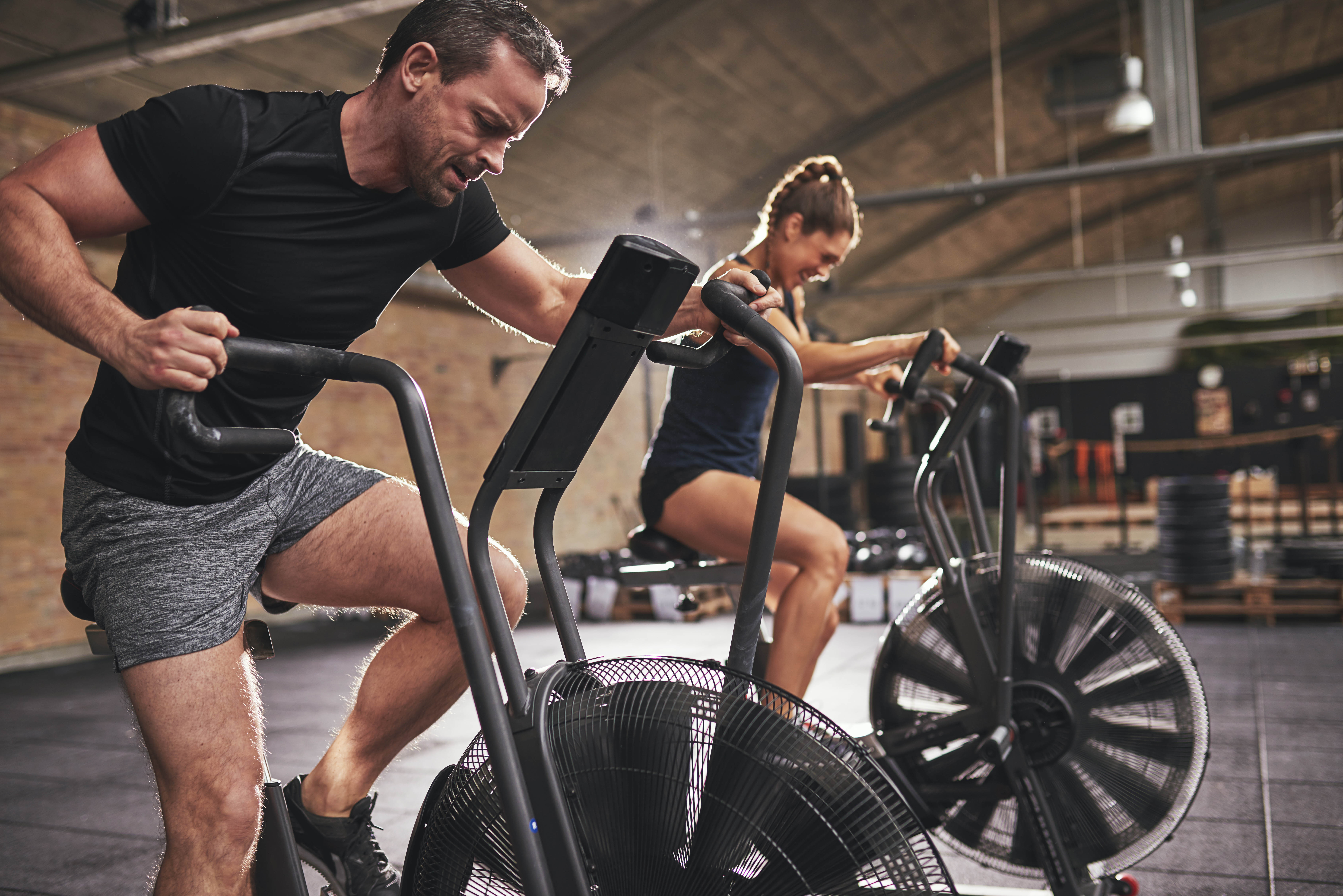Endurance Training: The Good, The Bad, and The Fabulous
Living Well

Written by: Meg Sharp, MSc., Fitness & Well-Being Consultant, Cambridge Group of Clubs
Endurance: Specifics and Benefits.
When we train for endurance, we improve our ability to take oxygen from the air, deliver it throughout the body, and use it effectively. Our heart, lungs, and circulatory system adapt. Our muscles and nervous system adapt.
As our heart pumps faster, our arteries dilate to allow more oxygenated blood to be carried to working muscles. With training, our cardiac muscle becomes stronger and our stroke volume increases. This means the heart can pump more blood with each beat. Our blood vessels become more flexible and increase in size and number, especially in the exercising limbs. This means more blood - and therefore oxygen - can be delivered to working muscles and your brain - every time your heart beats. We lower our risk of developing cardiovascular disease on a number of levels.

With endurance training, the muscles become more efficient at absorbing oxygen from the blood and converting nutrients into energy. This is, in part, due to the proliferation of capillaries around and within the muscles, as well as an increase in the number and function of mitochondria inside the muscle cells. Mitochondria produce the majority of the energy we require to move, exercise, and live, including producing hormones and neurotransmitters. They convert nutrients into adenosine triphosphate (ATP) which is the source of energy for most cellular processes. Because ATP can not be stored, our mitochondria work constantly. The more of them we have, and the better they function, and the harder and longer we can work. Physically and cognitively. As importantly, improving the health of our mitochondria improves health span and lowers risk of many diseases, including Alzheimer’s, dementia, Parkinson’s, cardiovascular disease, migraines, chronic fatigue syndrome, and amyotrophic lateral sclerosis.
This type of training promotes neuroplasticity improving cognitive function, reducing stress and anxiety, and decreasing depression. While there are obvious improvements in a person’s physical stamina, there’s recent evidence to support that training endurance also increases ability to concentrate longer, work through cognitively challenging tasks, and help muster the willpower to persevere mentally.

Endurance training supports improvements in body composition. We note an increase in lean tissue in the working muscles. Higher intensity aerobic activities burn a significant number of calories per hour. Over time, endurance training can increase the proportion of fat burned during exercise. As stress sometimes leads to less-than-optimal lifestyle choices - including consumption of alcohol or food that are high in calories but low in nutrient density - the positive emotional impact of aerobic exercise may be particularly helpful.

The take home? Endurance training is fabulous for you.
What gets in the way and what to do about it:
Boredom:
Relatively long, repetitive activity is not everyone’s jam. Dreading your workout - irrespective of how beneficial it is - isn’t a win. So, here are a few ideas to keep things interesting and fun:
- Start small. As your fitness increases, so will your tolerance for doing the same thing for a set period of time and you may find the time passes faster and faster.
- Bring someone or something along for the ride. Exercise with a friend, listen to a podcast, audiobook, the news, or a motivating playlist.
- Break it up: Do 10-15 minutes a day instead of 20-30 minutes every other day. Fit in a bout of cardio in the morning and another one at lunch.
- Do hybrid workouts: Add 3 10 minute bouts of cardio and repeat 2-4 times within your strength workouts.
- Go to one of our Spin Classes! Great music, social support, and a motivating instructor!
- Make your commute to or from work active. Nothing beats exercise with a practical purpose.
- Take it outside. The dynamic arena is stimulating, burns additional calories, and boosts cognitive and emotional benefits.
- Add intervals to create changes in pace and effort. It will make the time faster and, in some cases, makes the workout more effective. See below!

Injury:
All that moving meditation, powerful pounding, and super-hero grinding, can wreak havoc on our joints and muscles. With many aerobic activities, overuse injuries are the number one reason people have to stop! Here are a few strategies:
- Build gradually. Typical rule of thumb is to increase volume of training by no more than 10% per week.
- Check and balance your muscles. You almost certainly have musculoskeletal patterns - so use of specific muscles, joints, and pulls on certain aspects of your bones - that are used all the time. And a bunch that are neglected. As such, there are areas that need to be more mobile and some that need to be stronger. Ensure you’re giving those areas the care and attention they need. We’ll get to more specifics on this in the upcoming posts on Strength and Mobility.
- Rest: Ensure you are getting enough rest and recovery. If you’re doing any type of speed work or interval training it’s vital you get enough recovery between bouts to ensure efficient, safe mechanics. Rest between workouts is also important.
- Try upping the intensity instead of volume. Yes, if you want to be able to go further you need to train to go further… to an extent. There’s loads of great evidence to support that shorter, more intense efforts can help you achieve your ultimate distance goal as or even more effectively. For example, in lieu of running 15km one week, try running 10km at a faster pace. Instead of a steady state workout, warm up for 5-10 minutes, and then try 4 minutes of hard effort, followed by 4 minutes of easy effort. Repeat that sequence anywhere from 2-5 times depending on where you are in your volume cycle. Again, make sure you’re not going as far or as long. We’re looking for quality over quantity here.
“I just can’t make it through the prescribed workouts”:
As described above, endurance trains and, therefore, requires optimal functioning in a number of key areas. If you’re struggling to complete your workouts, look first to ensure you’re not adding volume too quickly. And ensure you’re getting adequate rest. Otherwise, maybe you need to improve your anerobic threshold. One of the best ways to do that is with some high intensity interval training or HIIT. This type of workouts is fun, challenging, and improves many aspects of your fitness, including your endurance.
Anaerobic Threshold: Your anaerobic threshold is the highest exercise intensity that you can sustain for a prolonged period of time. If you push past your threshold - by increasing intensity through pace/effort - the amount of oxygen being delivered by your cardiovascular system to the working muscles is insufficient to meet the higher energy requirements. Your body begins to rely more on anaerobic metabolism, where glucose is broken down to produce energy without sufficient oxygen leading to the buildup of lactate and hydrogen, and ultimately producing sufficient muscle fatigue and burning that will lead you to stop.

Take home: training your anaerobic threshold allows you to go further. Go harder. Recover faster.
In essence, most HIIT training involves short bursts of “all out effort” - 10-90 seconds - each followed by a period of rest. For the most part, the shorter bursts are harder (approaching 10/10) with 2-3x the recovery time. While work intervals of a minute will be a little more moderate and the recovery interval may be the same (1 minute). There are even “high volume HIIT” protocols involving hard efforts for up to 4 minutes with 4 minutes of easy recovery between, as described. As with every type of exercise, everyone is different. You want the quality of each HARD interval to be high. So even though they will get psychologically and physically tougher as you go, you still want to nail each and every interval. If you’re fatiguing too quickly and especially if you’re compromising safe form and good mechanics, you likely need slightly longer rest or shorter bursts.

Some of my favourite pieces at the Club to incorporate into HIIT (in every case, perform a movement specific warm-up for 5-10 minutes and cool down for another 5-10):
- The Sled: Load on a plate or two or four. Hip hinge forward, brace your core, and push like crazy to one end of the turf. Rest for at least as long as it took you to run the length. Then push the sled back!
- The Assault Bike: Go 15 seconds ALL OUT. Easy, easy, easy spin for 45-60 seconds. Repeat 5-10 times.
- The HEX Bar squat or deadlift: Once you’ve mastered this movement it can be fabulous for a HIIT style workout. Careful warm-up including a light first set, and then load so you can just complete each set within 5-6 reps. Rest. Repeat for 5-6 sets total.
- Stair Climber or Rowing Machine: Climb or Row as hard as you can for 45-60 seconds. Slow to a very comfortable pace for 60-90. Repeat 5-8 times.
Need some help figuring out what kind of HIIT workout is best for you? That’s right! We’d LOVE to cover the cost of a one-on-one session with one of our experts. Click below to make it happen!
Adelaide Club – Email Lauren
Cambridge Club – Email Sean
Toronto Athletic Club – Email Rob
2271